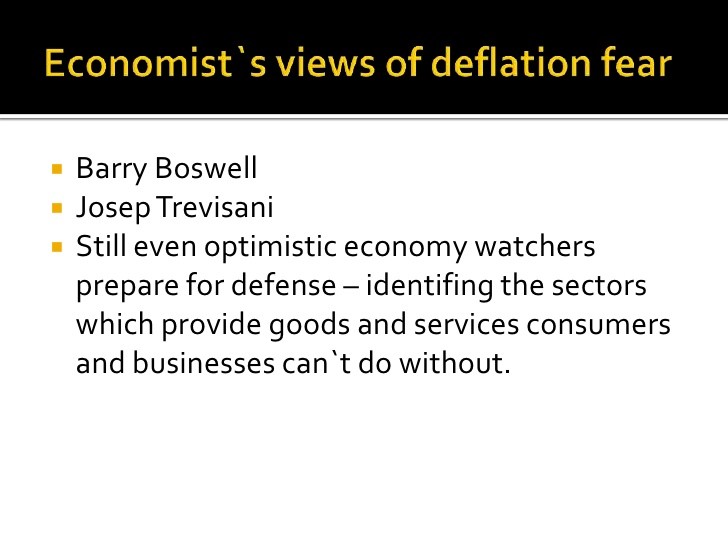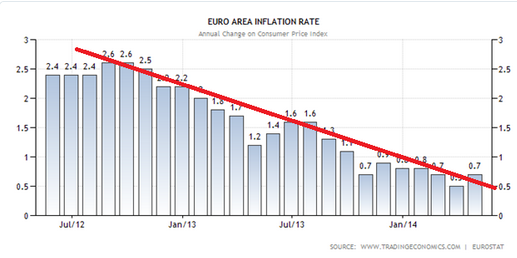How to protect your portfolio from deflation
Post on: 10 Июль, 2015 No Comment

This site uses cookies. Some of the cookies are essential for parts of the site to operate and have already been set. You may delete and block all cookies from this site, but if you do, parts of the site may not work. To find out more about cookies on the website and how to delete cookies, see our Privacy and Cookie Policy.
How to protect your portfolio from deflation
Inflation continues to dominate the economic debate, with some predicting its imminent arrival in a big way and others preaching its continued absence. As I pointed out in last week’s blog post. it is almost impossible to find two fund managers, economists or commentators with the same opinion of what might happen to inflation. This week I intend to focus on the case for a low inflation, or deflationary future.
The view that future inflation is going to be high, is based mainly on the impact of the current unconventional monetary policy being pursued by the Bank of England, the US Federal Reserve and very tentatively, and with great pains to make it look like anything but, the European Central Bank. Monetary policy is fairly complex, but US Federal reserve Chairman Ben Bernanke, in a moment of candour he’s surely already come to regret, once summarised the ideal policy as equivalent to printing money and dumping it from a helicopter. Conventional wisdom would suggest that this indeed would be inflationary, although estimates of how much vary from “a bit”, to “so high you should stockpile bottled water and ammunition.”
The counter argument can be summarised as follows: the current cause of economic woe is primarily due to a lack of demand. People are paying their debts off instead of buying anything, having over-done the credit card spending in the boom years before the credit crunch. Additionally, nervous business leaders are stockpiling cash rather than investing it, fearing worse economic news is just around the corner.
Yes, extra money is being pumped into the economy, but no one is willing to spend it. This phenomenon is being seen clearly with the big high street banks, which have taken large amounts of bailout cash and, instead of lending it out to businesses, have instead stockpiled government bonds. Rather ironically therefore, they are giving the government back the money they borrowed in the first place. Seemingly, the best thing that can be done with this excess money is to give it to governments, who can take up some of the slack until the private sector gets its house in order and starts shopping again.
This act won’t be inflationary because there is lots of spare capacity in the economy, even more that was previously imagined, according to a recent study by Capital Economics. In simple terms, the making of extra stuff will cancel out all of the extra currency, and prevent the value of the pieces of paper in your wallet from falling.
The more extreme interpretation is that this spare capacity is at critical levels, and that the government austerity program will depress demand even further, causing a spiralling round of price cuts as businesses try to clear their inventories. As people refuse to spend and lend, more and more cash will get stockpiled in bank vaults, reducing the amount of money in circulation. Having more goods than money available will cause prices to fall in search of equilibrium, similar to what we saw in Japan in the decade following its banking crisis in the 1990s. This was the biggest fear among central bankers following the credit crunch, which prompted their unconventional responses. However, even radical monetary policy may not be enough to prevent a Japanese-style stagnationary period.
Performance of index since June 1998
20&_graphics/20121019_japan.png /%
Source: FE Analytics
A low inflation environment doesn’t really need much insuring against. As far as investors are concerned it is the ideal case, although if it’s a symptom of slow sluggish economy, that will make decent returns harder to come by. Defensive equity funds with a focus on income producing companies will continue to be a good choice, in my opinion. Invesco Perpetual High Income. Trojan Income and Veritas Global Equity Income are three funds that have proven to be good bets when markets offer little in the way of growth, and which protect effectively against the downside during sell-offs.
Government bonds are being viewed with increasing suspicion at the moment as markets worry about rising debt levels and, should inflation start picking up, the possibility of an interest rate hike would decimate capital values.

However, one of the facets that predicts low inflation also predicts low interest rates. High debt levels are only a problem if people have less confidence in the government, but if no one is willing to spend anything, they’re likely to save, either by buying up government debt directly or indirectly by parking their money in the bank. In this case the excess of saving and low government bond yields have nothing to do with “market confidence” in austerity or central bank intervention. This is hotly disputed by many market experts, notably Bill Gross of Pimco and Terry Smith of Tullett Prebon. On the evidence of the last five years however, with gilt yields failing to react a great deal to the various QE programs, I’m sceptical.
In this scenario, funds such as five-crown rated SWIP Defensive Gilt are a good choice for investors looking to protect their capital. Its focus on short term government bonds makes it extremely low risk, and in a low inflation and interest rate environment a very good way to protect the real value of your investments. It should be noted that fund manager Graeme Caughey actually has a high inflation outlook, making the fund a good choice for investors who want to cover their tracks.
Other options include FE Alpha Manager Mike Amey’s Allianz Gilt Yield portfolio.
In a full blown deflationary environment, gold is viewed as the ultimate bunker asset, providing a good store value, just like it does in a high inflationary one. A gold ETF such as ETFS Physical Gold could be a good bet. However, unlike in a high inflationary environment, real assets such as oil or other commodities fall in price as demand continues to shrink.
Equities tend to do very badly in a deflationary environment as firms struggle with falling demand, as seen in Japan. Declining price levels often mean companies have to sell their goods at a lower real value than they paid for the materials. As seen in Japan, quality, well run companies can still prosper even when many of their rivals are suffering. Stock picking in this environment is extremely difficult however, and arguably it would be more luck than judgement to pick a fund manager who could successfully spot the winners.
Cash and bonds are a good way to maintain purchasing power, but ultra-low interest rates will offer virtually no income and investors will have to drawdown their savings. Corporate bonds will suffer from the same difficult corporate climate as equities thus increasing default rates, making government bonds the only “safe haven.” Again this is exactly what happened in Japan, allowing the government to borrow incredible amounts – its deficit is 230 per cent of GDP even now, far greater than Greece’s.
In truth there is little that can be done to shield a portfolio from full blown deflation. It really is a nightmare scenario and that is why most central bankers are much happier to court potential high inflation in order to ensure deflation is avoided. Government bonds and gold are the obvious choice, but in this scenario, today’s uncertain environment would look like a walk in the park by comparison.














